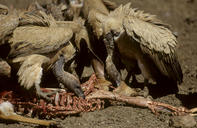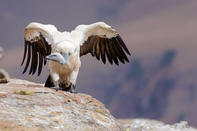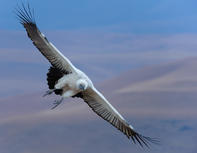Common in the Lowveld

White-backed vulture
Lappet-faced vulture
White-headed vulture
Hooded vulture
These species tend to fall into a feeding hierarchy at a carcass. Although there is some contest regarding the fixed order of this hierarchy, it is clear that the different species do perform different ‘duties’ at a feeding site.
White-Backed Vulture

The white-backed vultures are the most numerous and are frantic, noisy feeders hissing and mobbing one another to get their share of the spoils. White-backed vultures are comical birds and new arrivals bound in with wings and neck outstretched and can be seen bobbing from one leg to another, wings spread, to dominate a kill site.
They will feed right inside a carcass shearing meat from bones with powerful bills. They are extremely opportunistic and attempt to feed even while a predator is still present. They have even been known to chase less aggressive predators like cheetahs right off their kills.
King of Vultures

Generally however, most vultures, including the white-backed, have to await the arrival of the lappet-faced vulture in the case of a closed carcass. It is this ‘king of vultures’ that is adept at tearing open the skin of a closed carcass with its huge bill to get at the innards.
A lappet-faced vulture is the dominant species at a kill due to its size and power. They will eat tough remains such as skin, tendon, hair and ligament. The more solitary white-headed vulture generally remains to one side of the feeding activity, taking bits of meat and feeding a distance away.
The hooded vulture feeds on the softer organs like the eyes or intestines of a carcass. It also tends to hang around the edge of the feast snapping up scraps, which is often all that is available to it due to being pushed aside by the other larger, bossier species. The bill is small and adapted for probing into crevices after the frenzy is over.
Two Breeding Groups
Vultures can be divided into two main groups with regards to their breeding. Where the commoner species in the Lowveld are all tree-nesters, the Cape Vulture is a cliff nester. Vultures are all long-lived species that breed slowly.
The white-backed vulture tends to form loose colonies in suitable habitat, usually where large trees line a watercourse. Their nests are built at the very top of the tallest trees usually 15-25 m above ground. They prefer to nest in thorn trees as these offer protection from predators. The nest is a sturdy platform of sticks to support the large bodies of both adult and chick and the same site may be reused year after year, up to 15 years in one case.
Cape Vultures are extremely social and breed in colonies of between six and a hundred pairs on cliff faces. This provides the griffon with a good position, from which to launch their large heavy bodies into flight. Their grassy nests are positioned on ledges usually where there is some form of overhang.
The structure may vary from a few tufts of grass to elaborate structures, decorated with sticks stolen from a neighbour. Nests are also used year after year and eventually, the cliff faces become distinctively plastered with droppings.
The Marabou Stork is often found associating with vultures. Marabou is a French word meaning ‘ugly, misshapen old man’. They are unable to shear meat off a carcass with their straight bills and must rely on stealing bits that the vultures have worked free with their sharper beaks.
By Megan Emmet

